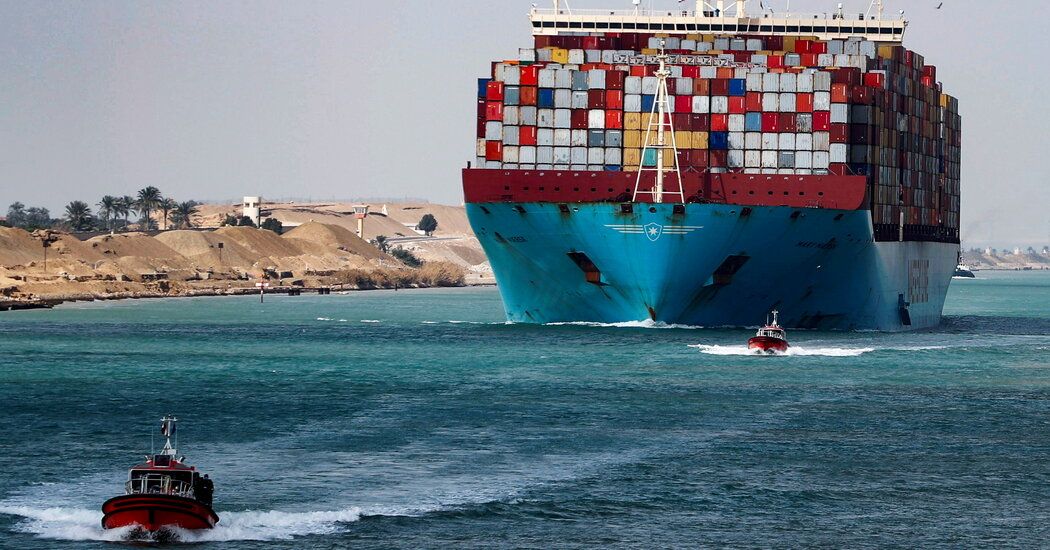Shipping companies that transport goods on one of the world’s busiest trade routes for factories, stores, car dealerships and other businesses face an excruciating decision.
They can send their ships through the Red Sea if they are willing to risk attacks by the Houthi militia in Yemen and bear the cost of much higher insurance premiums. Or they can sail an additional 4,000 miles around Africa, adding 10 days each way and burning considerably more fuel.
Neither option is attractive and both increase costs, expenses that analysts say could ultimately be borne by consumers through higher prices on the goods they buy.
“We are starting to see global supply chains being weaponized,” said Marco Forgione, director general of the International Trade and Export Institute, which supports British corporate efforts to expand into foreign markets.
In recent months, global supply chains have finally recovered after three years of disruptions caused by the pandemic and even a brief blockage of the Suez Canal, which lies at the northwestern end of the Red Sea and handles about 12 percent of world trade. Freight rates had fallen sharply and the long delays that had plagued retailers in the United States and Europe had been resolved.
So far, the problems in the Red Sea have not disrupted global supply chains to the same extent as the pandemic did. “But we are going in that direction,” Forgione said.
Houthi attacks have continued even after a US-led force was assembled in the Red Sea to prevent them.
Some companies, including Ikea and Next, the British retailer, have already said they will avoid the Suez Canal. Taking the long route around Africa could delay the arrival of products.
A crucial question will be how the container shipping industry handles the annual surge in exports that typically comes before China’s factories idle for weeks over the Lunar New Year next month.
The difficulties vary considerably depending on the type of boat. Tankers have been little affected and continue to use the Red Sea, as the Houthis appear to have shown little interest in them.
By contrast, the number of specialized car transport ships using the Red Sea more than halved last month from December 2022, to just 42 voyages, and only one has transited the sea so far. of the year, said Daniel Nash, head of vehicle transportation at VesselsValue, a London shipping data company.
The first ship attacked by Houthi gunmen in recent weeks was a car transporter, the Galaxy Leader, which was hijacked on November 19 while returning to Asia to carry another cargo of several thousand cars. The 25-member crew, mostly Filipinos, were also kidnapped and still do not appear to have been released.
Longer voyages around Africa for ships carrying cars traveling to Europe from Asia are particularly disruptive at the moment for the global auto industry. Chinese automakers have rapidly increased exports to Europe, especially of electric cars. Even before the Red Sea troubles, daily charter rates for ocean-going vehicles had soared to $105,000, from $16,000 two years ago.
The Red Sea disruption comes as the Panama Canal, which has low water levels caused by drought, has reduced the number of vessels that can pass through. This forced many ships to choose a longer route to the United States through the Suez Canal.
Websites that track shipping still show dozens of vessels in the Red Sea, which connects the Suez Canal and the Mediterranean Sea to the Arabian Sea and Indian Ocean. But larger companies have reduced their presence significantly or completely.
MSC, the largest container shipping company, said in mid-December that it was avoiding the Red Sea. Maersk, the second largest Red Sea transit ship, which then temporarily halted, returned to the area in late December and withdrew again this week after one of its vessels, the Maersk Hangzhou, was attacked.
French shipping company CMA CGM said in a statement that some of its ships had crossed the Red Sea and that it was planning a gradual increase in passages through the Suez Canal. “We are constantly monitoring the situation and are ready to quickly reassess and adjust our plans as necessary,” she added.
Cosco, the Chinese giant, did not respond to a request for comment. A spokesman for Hapag-Lloyd, which has a fleet of more than 250 container ships and is based in Hamburg, Germany, said the company planned to tour Africa until Jan. 9 and then assess the situation.
An analysis provided by Flexport, a logistics technology company, showed that as of Thursday, 389 container ships, representing more than a fifth of global container capacity, had already diverted from the Suez Canal or were in the process of doing so. .
“It’s about assessing risks and protecting life, property and cargo,” said Nathan Strang, director of marine transportation at Flexport. “If you can avoid a situation that puts you at existential risk by simply avoiding it, do it.”
Disruptions to transit through the Suez Canal are rare. But the canal was closed to international shipping for eight years after the 1967 Arab-Israeli war. Its reopening was “the happiest day of my life,” said Anwar el-Sadat, Egypt’s president at the time.
Some container ships still sailing through the Red Sea may be headed to or from ports there, such as those in Saudi Arabia. For financial reasons, some smaller container ships also continue to transit the Red Sea for voyages between Europe and Asia.
Ships carrying large quantities of containers can bear the additional costs of touring Africa, but, Strang said, the longer passage could destroy the economics of ships carrying 5,000 containers or fewer.
The quickest route to US East Coast ports from China is through the Panama Canal. But shipping companies that avoided that channel because of the drought now must sail longer as they bypass the Cape of Good Hope. The trip to the Cape takes 10 days longer, or about 40 percent longer, than traveling through the Panama Canal, Flexport estimates.
The cost of transporting a container to an East Coast port from China has skyrocketed to about $3,900 from $2,300 before the Red Sea attacks, says Zvi Schreiber, CEO of Freightos, a digital shipping marketplace. When shipping stagnation was worst during the pandemic, the cost could exceed $20,000.
Insurance costs, which normally do not exceed 0.2 percent of a ship’s value per voyage, rose to 0.7 percent for ships planning to enter the Red Sea, said the trade institute’s Forgione. “That’s a very significant increase,” she said.
Schreiber said he hoped shipping companies could handle the current disruption because, after buying more ships in recent years, they had plenty of extra capacity to cope with longer voyage times.
“While the shock is big and will probably end up being even bigger,” he said, “the network is coping.”
And Christian Roeloffs, co-CEO of Container xChange, an online container logistics platform, said in an email that China’s current supply chain disruptions seemed “relatively modest” compared to what happened when the country imposed lockdowns during the pandemic.
Siyi Zhao contributed to the research.










